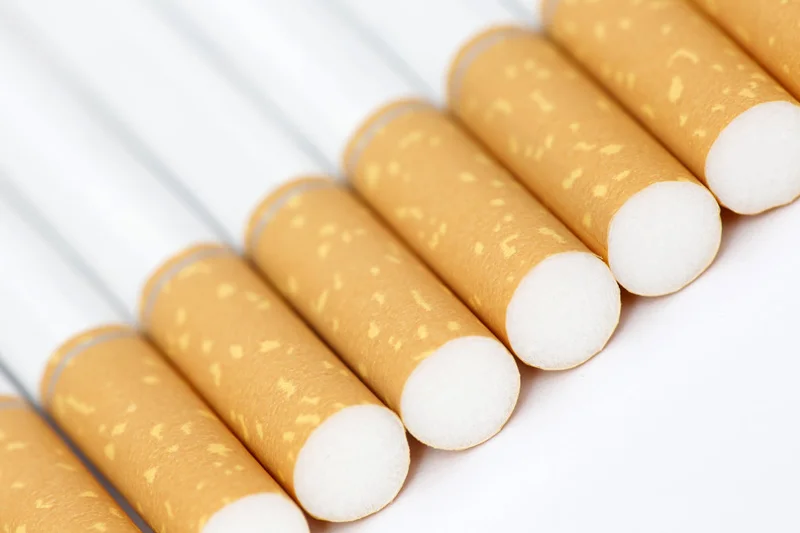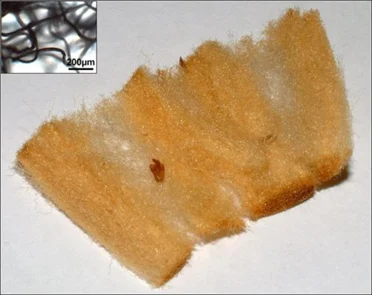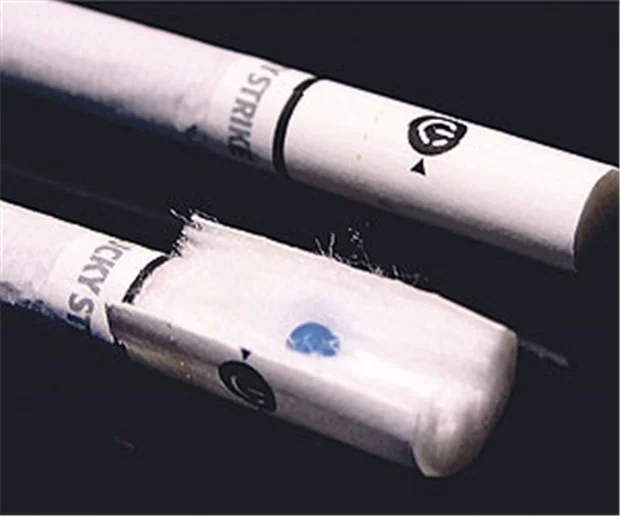Filter fraud
Presented by the tobacco industry as an effective solution to rid smoke of harmful substances, filters are of no use. They are even responsible for the increase in certain forms of cancer.
The first cigarette filter systems appeared around 1860. “It was then a matter of preventing tobacco particles from entering the smoker's mouth,” explains Thomas Novotny, specialist in the effects of smoke on health at the University of San Diego (US). The word “filter” appeared at the turn of the 20th century. But this appendage only really gained popularity from the 1940s and 1950s. “This coincides with the period during which we became aware of the harmful effects of smoke on health, in particular the risk of lung cancer”, specifies the epidemiologist.
Aware that this could have a deleterious effect on its sales, the tobacco industry immediately began looking for a tool to minimise the inhalation of dangerous substances. To do this, tobacco companies have turned to eminent research centers such as Princeton University, as well as to American chemical and synthetic fiber giants Dow, DuPont, Eastman Kodak, and Celanese.[1] Between 1954 and 1965, dozens of patents were filed for tobacco filtration systems.
Several methods were tried and abandoned. Natural fibers such as cotton and wool proved to be too inconsistent, making their large-scale production impossible. The manufacturing of cigarettes is in fact largely automated, carried out by machines that produce 250 pieces per second.[2]


The Lorillard group was interested in Kent Micronite, a filter made of crepe paper and asbestos fibers. But smokers found it too effective, as these cigarettes were tasteless. So this attempt was abandoned.[3] Other innovations included a filter that could be moistened to increase tar absorption, but it was considered too expensive and complex to produce. Then came a filter containing activated carbon designed to capture more gaseous substances, but these didn’t produce the expected results because the cigarette became too hot.[4]
The tobacco industry eventually agreed on the cellulose acetate fiber filter, which is inexpensive and easy to mass produce. The process involves treating cellulose, obtained from wood pulp, with acetic anhydride. This produces cellulose acetate chips, which are dissolved in acetone to obtain a viscose solution, then extruded as solid filaments. Gathered into a ribbon, tobacco companies then make a long tube of foam cut into segments.[5] The Celanese and Eastman Kodak companies quickly dominated the production of these new filters.
This innovation allowed tobacco companies to develop an advertising message hawking cigarettes claimed to be better for your health and to have a “milder” taste. In the 1970s and 80s, they introduced another novelty: ventilation through tiny perforations on the walls of the filter that allowed air to mix with the smoke of each puff, and therefore dilute harmful substances.[6] This gave rise to “light”, “ultra-light”, and “low-tar” cigarette claims.
The only problem is that the quantities of smoke inhaled are measured with a machine that takes 35-ml puffs every two seconds. “However, in reality, people do not smoke like this,” notes Thomas Novotny. “They sometimes cover the perforations in the filter with their fingers – consciously or not. They also tend to take more puffs and inhale more deeply to compensate for the loss of nicotine caused by the filter. Convinced that they are smoking less dangerous cigarettes, they also risk consuming more of them, he explains.
Studies measuring the quantities of harmful substances actually inhaled by smokers, through the analysis of certain biomarkers contained in their urine or their breath, confirm that they are almost identical for cigarettes with or without a filter.[7]

The lack of filter efficiency is not a recent discovery. It was already affirmed in the mid-1960s by the surgeon general of the United States.[8] More recently, in 2022, a Dutch court ruled that smoke measuring machines systematically underestimated the amounts of harmful substances inhaled, including nicotine, tar, carbon monoxide, and aldehydes, one of the most common components of toxic smoke.[9] Today, both in the European Union and in Switzerland, the designations “light”, “mild”, and “low tar” are prohibited.[10]
The tobacco industry has also known since at least the end of the 1950s that its filters have no impact on the health of smokers. In a 1961 presentation to the Philip Morris Research & Development Committee, H Wakeham, then-vice president of R&D, said that available technologies "do not allow for selective filtering of smoke particles."[11] Phillip Morris actively sought to conceal this fact, aware that an effective filter would reduce the quantity of nicotine delivered and the sensation of inhaling smoke, which are at the heart of the smoker's addiction.
But far from being just an ineffective appendage, the filter carries its own share of danger. “Since the introduction of the filter, adenocarcinoma has replaced squamous cell carcinoma as the most common lung cancer,” notes Thomas Novotny. Adenocarcinoma occurs in the epithelial cells of the lung, responsible for producing mucus, while squamous cell carcinoma arises in the flat cells lining the respiratory tract, i.e. in the bronchi.
If the incidence of adenocarcinoma compared to squamous cell carcinoma was only 1:18 in 1950 in the United States, but it rose to 1:0.64 in men and 1:0.37 in women by 2010.[12] The incidence of the adenocarcinoma overtook that of squamous cell carcinoma in around 1990.
A similar trend was observed in Europe and Japan. In Belgium, the ratio between the two cancers was 1:0.59 for men and 1:0.25 for women in 2020.[13] The lower rates of squamous cell carcinoma in women can be explained by the fact that they only started smoking en masse in the 1960s, when filters were introduced. Women were therefore less exposed to the substances causing squamous cell cancer, delivered in greater quantities by unfiltered cigarettes.
On the other hand, just like men they have suffered the full brunt of the spectacular increase in adenocarcinoma that coincided with the arrival of filtered cigarettes. Filters slow down combustion and lower the cigarette’s temperature, since less oxygen penetrates the cigarette. This increases the formation of certain carcinogens such as nicotine-derived nitrosamine ketone (NNK), known to promote adenocarcinoma.[14]
Added to this are the more intense inhalations taken by the smoker to compensate for the filtration effect, which cause the smoke to penetrate deep into the lungs, reaching the distal respiratory tract where cells are particularly conducive to adenocarcinoma.[15] In 2014, the surgeon general in the United States concluded that the increase in adenocarcinoma recorded in the country since the 1960s was largely due to the introduction of ventilated filters.
Another harmful health effect is that the filters release tiny cellulose acetate fibers coated with carcinogens when inhaled. “We have found these in the lungs of deceased smokers,” notes Debbie Sy, in charge of strategic affairs for the Global Center for Good Governance in Tobacco Control.
This manufacturing defect has been known to tobacco companies for a long time, as they have carried out numerous studies confirming it since the early 1960s. Philip Morris even invented the term “fall-out” to describe this involuntary diffusion of filaments. The results of this research, however, have never been made public. Philip Morris even reportedly demanded the destruction of some of these documents in the mid-1990s.[16]
Despite the many dangers they pose and their lack of positive impact on the health of smokers, the composition of cigarette filters has changed little over the last 40 years. At most, their pH was manipulated so that they took on a brownish color after being used, because tobacco companies realised that this reassured smokers about their effectiveness. Filters were made firmer and varieties were enhanced with a menthol flavour.

More recently, the tobacco industry has marketed filters decorated with a bubble that can be crushed to flavour cigarettes, including many flavours such as apple or strawberry that popular with adolescents. Flavoured cigarettes have since been banned in many countries, including the European Union and the United Kingdom.[17] In Switzerland, however, they are still on sale. Parliament actually refused a motion last spring that aimed to ban them.[18]
[1] https://pubmed.ncbi.nlm.nih.gov/21504917/
[4] https://www.industrydocuments.ucsf.edu/tobacco/docs/#id=rthl0118
[5] https://www.industrydocuments.ucsf.edu/tobacco/docs/#id=jthl0038 et Howell CJ Jr., Trott DW, Riley JL, et al. Process for Extruding Plasticized Open Cell Foamed Cellulose Acetate Filters. United States. 4180536 (Patent). 25 December 1979.
[6] https://pubmed.ncbi.nlm.nih.gov/33903277/
[7] https://pubmed.ncbi.nlm.nih.gov/16973339/
[8] https://pubmed.ncbi.nlm.nih.gov/21504917/
[9] https://www.frontiersin.org/journals/public-health/articles/10.3389/fpubh.2023.1282655/full#ref32
[10] https://pubmed.ncbi.nlm.nih.gov/33903277/
[11] https://www.industrydocuments.ucsf.edu/tobacco/docs/#id=xxcf0115
[12] https://www.frontiersin.org/journals/public-health/articles/10.3389/fpubh.2023.1282655/full#ref32
[13] https://www.ncbi.nlm.nih.gov/pmc/articles/PMC6059254/
[14] https://www.ncbi.nlm.nih.gov/pmc/articles/PMC6059254/
[15] Ibidem
[16] https://www.jstor.org/stable/20208005